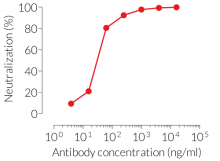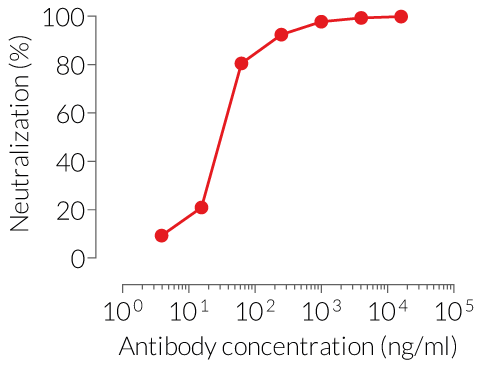Recombinant anti-mouse IL-6 antibody - Clone 10F9 (D265A)
| Product | Unit size | Cat. code | Docs. | Qty. | Price | |
|---|---|---|---|---|---|---|
|
Anti-mIL-6-mIgG1e3 Recombinant mAb against mouse IL-6 (clone 10F9), D265A effectorless. For in vitro use |
Show product |
200 µg |
mil6-mab15-02
|
|
||
|
Anti-mIL-6-mIgG1e3 InvivoFit™ Recombinant mAb against mouse IL-6 (clone 10F9), D265A effectorless. For in vivo use |
Show product |
1 mg 10 mg |
mil6-mab15-1
|
|
Notification: Our anti-mouse IL-6-rIgG2a antibody raised in rat and produced in hybridoma (mabg-mil6-3) has been removed from our catalog. Its coding sequence has been determined and the antibody is now produced by recombinant technology and purified from CHO cells. Additionally, it contains a murine engineered constant region (IgG1e3) featuring a point mutation (D265A) to abolish effector functions.

InvivoGen’s engineered Anti-mIL-6-mIgG1e3 antibody
Recombinant murinized IL-6 antibody
InvivoGen provides a recombinant muninized anti-mouse IL-6-mIgG1e3 monoclonal antibody (mAb) that was previously extracted from hybridoma. It is now expressed and produced in Chinese hamster ovary (CHO) cells, ensuring reliability and lot-to-lot reproducibility. Thereby, common hybridoma-related drawbacks such as the generation of non-relevant mAbs containing aberrant light chains are avoided [1].
Additionally, the rat-derived constant region was replaced by a murine constant region, making the mAb ~65% of murine origin. Anti-mIL-6-mIgG1e3 now consists of the variable region of a rat anti-mIL-6 mAb (clone 10F9) and the engineered murine IgG1 constant region. Within the IgG1e3 isotype, a point mutation D265A was introduced leading to a complete loss of unwanted Fc-associated effector functions [2]. Altogether, these alterations increase antibody performance and overcome immunogenic events, especially in vivo [3].
InvivoGen provides this antibody in two grades:
- In vitro use: Anti-mIL-6-mIgG1e3
- In vivo use: Anti-mIL-6-mIgG1e3 InvivoFit™
All InvivoFit™ products are handled in a clean room, filter-sterilized, and tested for bacterial contaminants. Additionally, this grade guarantees low levels of endotoxins (<1 EU/ml). The buffer formulation is specifically adapted for in vivo studies.
Key features:
- Potent and specific neutralization activity against mIL-6
- Sequence is 65% murine
- Murine IgG1e3 isotype (constant region)
- mIgG1e3 (IgG1 with a replacement of aspartic (D) acid by alanine (A) at position 265 point mutation) is effectorless
- Free from non-relevant mAbs found in hybridoma-based productions
- Produced in animal-free facilities and defined media
- Low aggregation < 5%
- InvivoFit™ grade is available
Anti-mIL-6-mIgG1e3 is designed to efficiently neutralize the biological activity of mIL-6 without triggering any effector functions. Interleukin 6 (IL-6) is a pleiotropic cytokine involved not only in immune responses but also in inflammation, hematopoiesis, bone metabolism, and other fundamental processes [4].
References:
1. Bradbury, A. et al. 2018. When monoclonal antibodies are not monospecific: Hybridomas frequently express additional functional variable regions. mAbs, 10(4), 539–546
2. Baudino L. et al., 2008. Crucial role of aspartic acid at position 265 in the CH2 domain for murine IgG2a and IgG2b Fc-associated effector functions. J. Immunol. 181(9):6664-9.
3. Brüggemann M. et al., 1989. The immunogenicity of chimeric antibodies. J. Exp. Med. 170:2153-2157.
4. Hirano T., 2021. IL-6 in inflammation, autoimmunity and cancer. Int Immunol. 1;33(3):127-148.
Specifications
Target: Murine IL-6 (mIL-6)
Specificity: No cross-reactivity with human IL-6
Clone: 10F9
Source: CHO cells
Isotype: Murine IgG1e3 (D265A mutation; no effector function), kappa
Control: Murine IgG1e3 Isotype Control
Formulation of Anti-mIL-6-mIgG1e3: Lyophilized from 0.2 µm filtered solution in a sodium phosphate buffer with glycine, saccharose, and stabilizing agents.
Formulation of Anti-mIL-6-mIgG1e3 InvivoFit™: Lyophilized from 0.2 µm filtered solution in a sodium phosphate buffer with 5 % saccharose and 0.25% Polysorbate 80
Tested applications: Blocking & Neutralisation
Quality control:
- These products have been validated using neutralization cellular assays.
- The complete sequence of these antibodies has been verified.
- The absence of bacterial contamination (e.g. lipoproteins and endotoxins) has been confirmed using HEK-Blue™ TLR2 and HEK‑Blue™ TLR4 cells.
- The endotoxin level in Anti-mIL-6-mIgG1e3 InvivoFit™ is <1 EU/mg (determined by a LAL assay).
Contents
Please note: Each mAb is sold separately. See TDS for the exact contents.
Anti-mIL-6-mIgG1e3
- mil6-mab15-02: 200 µg, lyophilized
Anti-mIL-6-mIgG1e3 InvivoFit™
- mil6-mab15-1: 1 mg, lyophilized
- mil6-mab15-10: 10 mg, lyophilized
![]() The product is shipped at room temperature.
The product is shipped at room temperature.
![]() Store lyophilized antibody at -20 °C.
Store lyophilized antibody at -20 °C.
![]() Lyophilized product is stable for at least 1 year.
Lyophilized product is stable for at least 1 year.
![]() Avoid repeated freeze-thaw cycles.
Avoid repeated freeze-thaw cycles.
InvivoFit™
InvivoFit™ is a high-quality standard specifically adapted to in vivo studies. InvivoFit™ products are filter-sterilized (0.2 µm) and filled under strict aseptic conditions in a clean room. The level of bacterial contaminants (endotoxins and lipoproteins) in each lot is verified using a LAL assay and a TLR2 and TLR4 reporter assay.
Back to the topDetails
The proinflammatory cytokine IL-6 is one of the most important mediators in the regulation of the immune response, hematopoiesis, and inflammation [1]. It plays roles in chronic inflammation, autoimmune diseases, and cancer. In addition, it has been reported to be involved in the cytokine storm triggered by the corona virus disease 2019 (COVID-19) [2].
IL-6 exerts its action by first binding to the IL-6 receptor (IL-6R). The complex of IL-6 and IL-6R associates with the signal-transducing membrane protein gp130, thereby inducing its dimerization (figure 1). This leads to the downstream activation by phosphorylation of certain tyrosine kinases within the Janus family (JAK1, JAK2, and Tyk2). Subsequently, activated JAKs induce phosphorylation, dimerization and translocation of the signal transducer and activator of transcription 3 (STAT3) to the nucleus where it binds enhancer elements of IL-6 inducible genes [3]. Considering the various properties of this pleiotropic cytokine, the IL-6–STAT3 signaling axis is now considered a major target for the treatment of inflammatory diseases [2].
References:
1. Kang S. et al., 2015. Therapeutic uses of anti-interleukin-6 receptor antibody. Int. Immunol. 27: 21-9.
2. Hirano T., 2021. IL-6 in inflammation, autoimmunity and cancer. Int Immunol. 1;33(3):127-148.
3. Murray P., 2007. The JAK-STAT Signaling Pathway: Input and Output Integration. J. Immunol. 178:2623-9.






